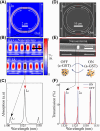Spatio-spectral control of coherent nanophotonics
- PMID: 39634506
- PMCID: PMC11501196
- DOI: 10.1515/nanoph-2023-0651
Spatio-spectral control of coherent nanophotonics
Abstract
Fast modulation of optical signals that carry multidimensional information in the form of wavelength, phase or polarization has fueled an explosion of interest in integrated photonics. This interest however masks a significant challenge which is that independent modulation of multi-wavelength carrier signals in a single waveguide is not trivial. Such challenge is attributed to the longitudinal direction of guided-mode propagation, limiting the spatial separation and modulation of electric-field. Here, we overcome this using a single photonic element that utilizes active coherent (near) perfect absorption. We make use of standing wave patterns to exploit the spatial-degrees-of-freedom of in-plane modes and individually address elements according to their mode number. By combining the concept of coherent absorption in spatio-spectral domain with active phase-change nanoantennas, we engineer and test an integrated, reconfigurable and multi-spectral modulator operating within a single element. Our approach demonstrates for the first time, a non-volatile, wavelength-addressable element, providing a pathway for exploring the tunable capabilities in both spatial and spectral domains of coherent nanophotonics.
Keywords: active photonics; phase-change materials; photonic spatio-spectral reconfiguration.
© 2023 the author(s), published by De Gruyter, Berlin/Boston.
Conflict of interest statement
Conflict of interest: Authors state no conflicts of interest.
Figures




References
LinkOut - more resources
Full Text Sources
